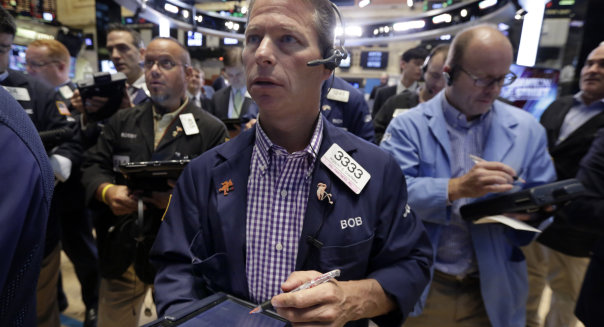
NEW YORK — Wall Street ended lower Monday and wrapped up its worst month since 2012 after a senior Federal Reserve official heightened fears among investors of a potential U.S. interest hike in September.
Fed Vice Chairman Stanley Fischer said Saturday that U.S. inflation would likely rebound as pressure from the dollar fades, allowing the Fed to raise interest rates gradually.
Many analysts took Fischer’s comments as a sign the Fed would raise rates in September, instead of December. That shook investors who were already jumpy after weeks of turbulence caused by concerns about a stumbling Chinese economy.
What you see in the market today is caused by Fischer’s comments over the weekend.
“What you see in the market today is caused by Fischer’s comments over the weekend. If they move in September, it’s going to cast a lot of doubt about where they will stop,” said Stephen Massocca, chief investment officer at Wedbush Equity Management in San Francisco.
Fischer’s remarks at the global central banking conference in Jackson Hole, Wyoming, suggested the Fed doesn’t see the recent stock market drop and concerns about China as reasons that would keep it from raising rates.
A decade of near-zero interest rates has helped the U.S. stock market stage a spectacular bull-run since the financial crisis and investors are worried those gains many end once rates start to climb.
The CBOE Volatility index, known as Wall Street’s “fear gauge,” rose about 9.1 percent to 28.43, above its long-term average of 20. It spiked to as high as 53.29 last week.
Investors will keep a sharp eye Friday on the Labor Department’s monthly jobs report, which will be the last one before the Fed meets Sept. 16-17.
“We can still expect to see some significant drops in the market until we get some direction from the Fed regarding a rate increase,” said John DeClue, chief investment officer of U.S. Bank Wealth Management.
The Dow Jones industrial average (^DJI) lost 0.7 percent to end at 16,528.03 points and the Standard & Poor’s 500 index (^GSPC) fell 0.8 percent to 1,972.18. The Nasdaq composite (^IXIC) dropped 1.1 percent to 4,776.51.
Nine of the 10 major S&P sectors were lower with the health index’s 1.85 percent fall leading the decliners.
Energy Gains
The S&P energy index rose 1.1 percent and was on track for its best four-day gain in seven years, boosted by ConocoPhillips (COP) and Phillips 66.
Crude oil prices jumped after data indicated surprise cuts to U.S. oil production and as OPEC said it was ready to talk to other producers about the recent drop in prices.
In August, the S&P lost 6.3 percent, the Dow fell 6.6 percent and the Nasdaq declined 6.9 percent.
On Monday, Celgene (CELG) fell 4.8 percent, weighing the most on the S&P 500. Phillips 66 (PSX) rose 2.4 percent after Warren Buffett’s Berkshire Hathaway (BRK-B) disclosed a $4.48 billion stake in the oil refiner.
Declining issues outnumbered advancers on the NYSE by 1,724 to 1,339. On the Nasdaq, 1,432 issues fell and 1,380 advanced.
The S&P 500 index showed one new 52-week high and two new lows, while the Nasdaq recorded 24 new highs and 22 new lows.
-.
What to watch Tuesday:
Automakers release vehicle sales data for August.
At 10 a.m. Eastern time, the Institute for Supply Management releases its manufacturing index for August, and the Commerce Department releases construction spending for July.
Earnings Season
These selected companies are scheduled to release quarterly financial results:
Dollar Tree (DLTR)
H&R Block (HRB)
•Wall Street Rallies on Fed Rate Hike
•Fed Raises Interest Rates, Cites Ongoing US Economic Recovery
•US Aerospace Sector Poised for 2015 Record Trade Surplus: Group


Leave a Reply